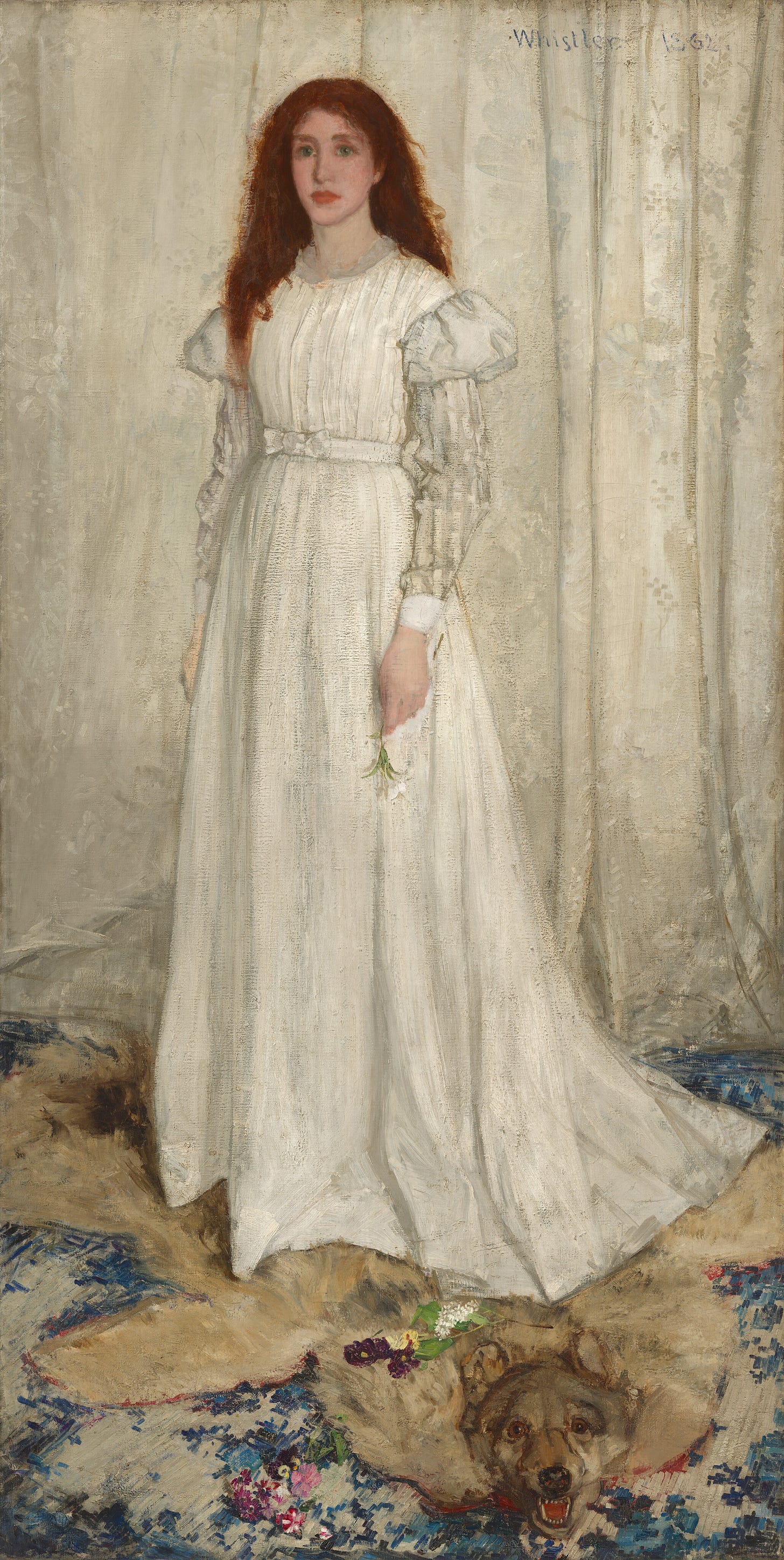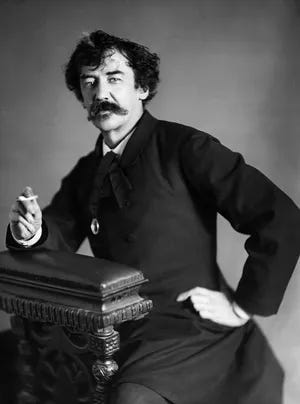Man, I Feel like a Whistler Woman
An analysis of James McNeill Whistler's Symphony in White, No. 1: The White Girl
21st & 18th writes about culture. Covering art, history and fashion and featuring interviews with voices in fashion and leaders in the arts. Written by Lauren Lynch Wemple (@lolynchwemple). Follow 21st & 18th (@21stand18th) on Instagram.
ART
Right now, with everything happening in America and the wider world and my multiple businesses sucking at my soul (I’m a creative production & retail GTM consultant1 & operate a textile goods business2) I am feeling how the girl in Whistler’s Symphony in White looks: dejected.

At least that’s what I get from her, a dispirited energy looking to others for a boost or direction. What do you see in her?
The first time I was asked, “What is your favorite work of art?” was during AP Art History I know I was annoying during my senior year of high school in North County San Diego. We wore uniforms and our teacher used old school photo slides. It was basically Mona Lisa Smile.
Anyhow, annoying and wearing plaid or not, I answered the question with, “Nocturne in Black and Gold by James McNeill Whistler.” At the time, I liked how the painting made me feel, and how it was murky with a thousand possible perspectives. Then, a senior in high school preparing to leave California for Pennsylvania and head to college, I was on the cusp of something. A great change. I knew the coming new season would bring good and bad and the grey between, but I was looking forward to it, and this painting reminded me: our most revelatory moments come in those in-between, usually oddly grey times.

James McNeill Whistler
Born in 1834 in Lowell, Massachusetts, James Abbott Whistler was the third son of a military man cum civil engineer, Major George Washington Whistler what a name, and his second wife Anna Matilda McNeill ah there’s the McNeill. Whistler and his family moved around New England before his father moved the lot of them to St. Petersburg, Russia plot twist as he was contracted to oversee the construction of a railroad line connecting their new hometown with Moscow. Time spent studying drawing at the Imperial Academy of Science was Whistler’s first proper introduction to art. In 1848 Whistler lived briefly with his older sister and brother in-law in London but the family’s European adventures were cut short by the sudden death of his father in 1849, after which the family returned to the United States and Whistler enrolled in West Point, the well known United States Military Academy happened to be his father’s alma mater as well.
Despite reportedly shining in his creative classes, Whistler was ‘dismissed’ from West Point in 1854, and went on to a few jobs here and there in the North East and Mid Atlantic USA. Nothing really stuck but his love of and interest in drawing and as you do Whistler decided he would become and artist and packed up to move to Europe.
Where did Whistler go in Europe? Paris obviously. Consider the times, France was obsessed with Realism3 in the wake of the country’s 1848 Revolution which overthrew the re-established monarchy classic and established the Second Republic. Because of the political and social shifts that seemed a constant, there was a lot of cultural energy brewing in Paris.
In Paris, Whistler enrolled in the Ecole Imperiale et Speciale de Dessin prior to entering into the Academie Gleyre. While studying and working, he chummed it up with avant garde artists and found great inspiration in the work of Courbet4 as well as 17th century Dutch5 and Spanish masters6.
Whistler’s time in Paris came to an end in 1859 when the Salon rejected his work, At The Piano. What did Whistler do? He packed up and moved to London where the Royal Academy happily exhibited the painting. Funnily enough, the painting that would bring Whistler international acclaim, Symphony in White, No. 1: The White Girl, was rejected by both the Paris Salon and London’s Royal Academy.
Whistler moved from England to South America in 1866.
In the 1870s he began signing his paintings with a butterfly composed of his initials and created his Nocturne series (mentioned above). After the art critic, John Ruskin7, denounced the aforementioned series as the equivalent to “flinging a pot of paint in the public's face” in 1877, Whistler moved to Italy with a besmirched reputation and after suing Ruskin but being awarded so little money he declared bankruptcy in 1879.
1880 brought Whistler’s return to England, where he would spend the next 23 years of his life living and working and achieving great artistic acclaim. He died in 1903 in London after a long and fruitful albeit dramatic career in the arts and having been elected president to London’s Society of British Artists, Royal Academy of Fine Arts, Munich, and the Legion d'Honneur.
Let’s dissect The White Girl
Rejected from both the Salon in Paris and by the Brits at the Royal Academy. Interesting huh? The female character represented in Symphony in White: The White Girl has an angelic glow around her, made more stark by her being in a long, white gown with long sleeves and a conservative neckline and Whistler’s painting technique which creates a hazy halo around her hair and puffed dress sleeves.
While the gal looks and is dressed like a young angel, she seems older or at least to have experienced the complexity of life. To me, she doesn’t seem to be a young and sheltered woman. I think she’s been through it.
Also note Whistler’s painting technique and use of varying shades of white, with darker colors, to create lines and form in an almost entirely white subject and backdrop. It becomes a trying optical illusion if you stare at it long enough. While I’ve got you staring, notice how the soft and gentle addition of greys and browns amid loads of shades of white creates form and movement, you can feel the girl’s elbows bend and hear the linen and silk of her dress crunch.
There is very little color in this painting. In the girl’s hand we see a white flower. What sort of flower is it? Is it blooming or wilting? Are these features even important? Famously Whistler painted this girl, who in real life was an Irish immigrant, living in London, named Joanna Hiffernan8, twice more and insisted the trio of paintings was only about understanding the abstract qualities of line and color. Perhaps there really is no meaning to the flower.
Most of the color in the painting is relegated to the foreground, the carpet and bear fur at the subject’s feet, partially hidden beneath her dress. There are additional flowers, fallen from her hand lying atop the insane bear rug.
While absurd, this skinned and upset bear resonated with me today.
Looking back at the entire painting, I’m confused. I don’t really know what I’m looking at or why. Is it for the study of and understanding of color? Did Whistler paint with abstraction in mind but Joanna’s life experience shone through anyhow? Is she sad or bored? Or both?
Now this is the moment Whistler’s work, for me, becomes genius because it often leaves the viewer with such a confusion, and the viewer then begins to reflect, whether they realize it or not, on the work before them. Such reflections are typically contorted by what we’re feeling, going through in life, people we might be viewing the work with etc etc. For me, this is the moment when Whistler’s art becomes human. Almost animated. Because it becomes a mirror.
HISTORY & FASHION honorable mentions
HISTORY Do you follow DC’s National Gallery of Art on Instagram? If no, you should. Particularly if you like history, art and being entertained. Whoever is at the helm of their social ship is crushing it. Follow here: @ngadc
HISTORY Looking for your next read? Historical fiction lovers should queue up Kristin Hannah’s The Nightingale. Two sisters, two stories of love, values and family set in WWII France. Learn more here.
FASHION My most complimented piece of clothing over the past year is the Luisa pleated trousers in a muted brown. They’re by Staud and currently on sale for $173 and available in sizes 0 - 16.
FASHION Also on a lowers kick, I purchased these green and white striped Twill Trousers from Talbot’s yesterday and have already worn them twice. Don’t sleep on the stores your mother loves. $109 and available in sizes 2 - 18, as well as petite and plus size.
Realism as an art movement focused on representations of everyday life and subjects in a naturalistic way while also imbuing scenes with social commentary.
Gustave Courbet (b. 1819 - d. 1917) was a French painter who led the Realist painting movement in the 19th century. He was dedicating to painting only that which he could see and distanced himself from the painters who came before him and favored academic convention or were part of the Romantic period. Likely, you would recognize his 1845 painting The Desperate Man.
Dutch master painters of reference would be the likes of: Frans Hals, Rembrandt Van Rijn, Johannes Vermeer and Jan Steen, among others.
Spanish master painters who influenced Whistler might be the likes of: El Greco, Diego Velázquez and Francisco Goya, among others.
John Ruskin (b. 1819 - d. 1900) was an English polymath, who counted writer, lecturer, art historian and art critic among the list of his many professions. Based on his libel suit with Whistler, he sounds like a pedantic ass. But I do not possess a time machine and have no experiential evidence supporting such.
Joanna Hiffernan (b. 1843 - d. 1886) was Irish immigrant with little standing in British society. She became Whistler’s primary model and collaborator during the early 1860s. Hiffernan also worked with Gustave Courbet.












If you're keen, navigate to NGA's online collection to view more of Whistler's artwork: https://www.nga.gov/collection/artist-info.1974.html#works